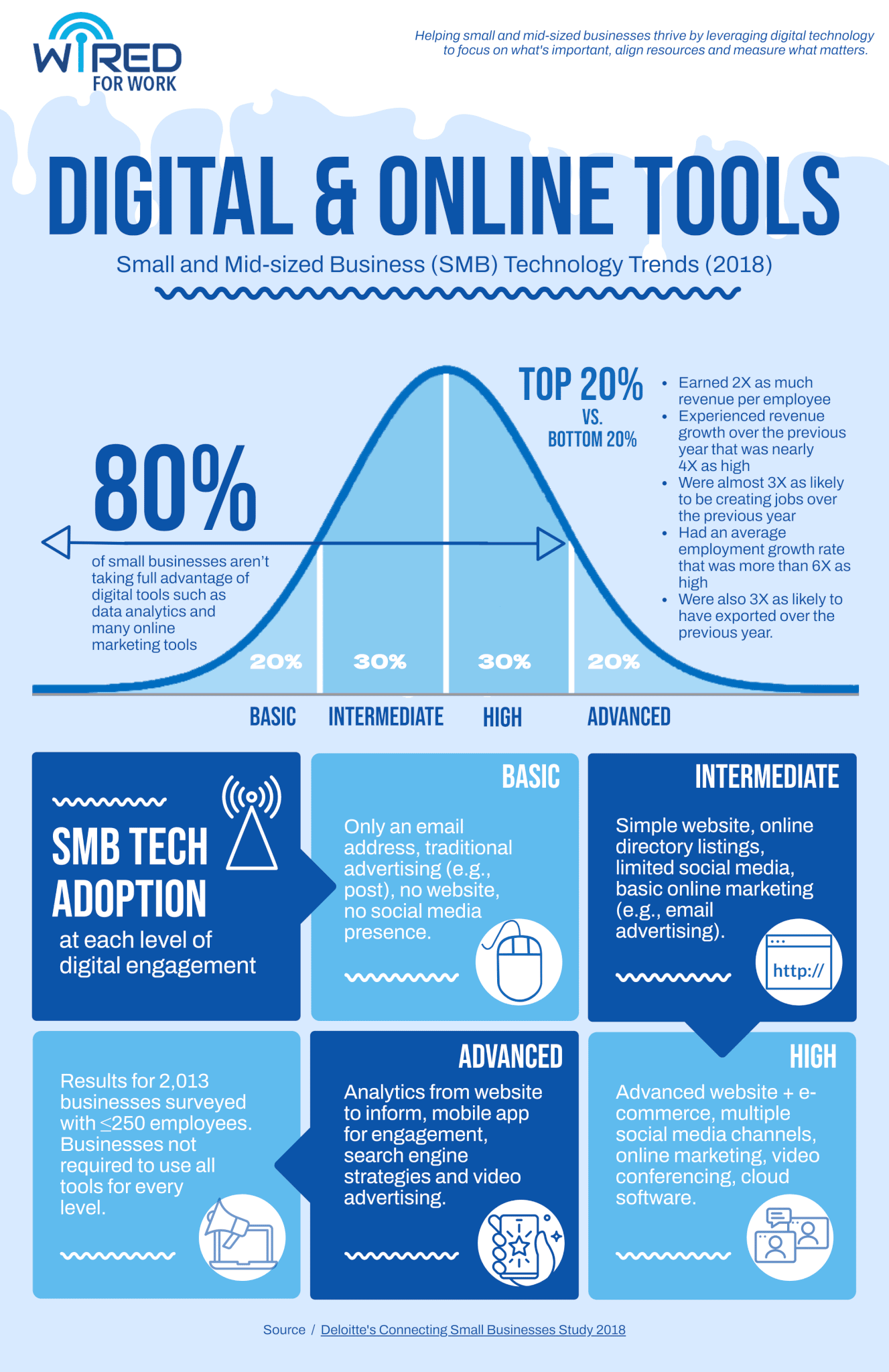The benefits to businesses using digital tools are significant. Because of the relatively small cost, digital tools are enabling small and mid-sized businesses (SMBs) to access new markets and target new customers that would not have been possible before.
As a reminder, Deloitte’s analysis in Connected Small Businesses in the US report a few years ago showed how digitally advanced small businesses realized significant benefits compared to businesses with low levels of digital engagement. For starters, they:
- Earned 2X as much revenue per employee
- Experienced revenue growth over the previous year that was nearly 4X as high
- Were almost 3X as likely to be creating jobs over the previous year, among other benefits
However, despite these potential gains, 80% of US small businesses were not taking advantage of the tools available to them. The infographic below shows the distribution spread of digital tool adoption among SMBs and the types of tools that were used.
If you’re in that 20% who are just getting started, no worries. In Starting With the Basics – Part 1 – Small Business Websites, we explored why one-page microsites may be a good choice for you to get started. Part 2.1 will show you how you can use social media to market your business and begin to take advantage of this valuable online tool.
Social Media Benefits
Social media is a network that attracts all demographics and is a marketing dream come true. It offers free access to a huge audience of prospective customers for anything. It’s safe to say that this tool is a staple in every marketing professional’s marketing toolbox.
Many SMBs mistakenly think that social media is only for businesses with huge marketing budgets. Not so. In fact, social media platforms are a great opportunity for small brands to grow within a close-knit community of both present and future customers.
Following are three ways that social media marketing can help SMBs:
- Generate Brand Awareness – Social media has an advantage over TV, radio, magazines and other traditional media platforms because you can spread information about your business in a quick and cost-effective way, potentially reaching huge numbers of people with your message. This can mean more sign-ups for your services, more followers for your business, and higher conversions for your marketing campaigns.
- Increase Site Traffic – If you have a business website, you can leverage social media to direct traffic to your site. It can also improve the quality and quantity of your inbound traffic as well as help with SEO optimization efforts you might have.
- Sell Products And Services – You can also directly market your products by targeting your prime audience with ads on such platforms as Facebook and Instagram, getting your content directly in front of purchasers.
Getting Started
To get started with social media marketing, you should begin by visiting the sites and see how things are done, very much in the same manner as traditional marketing. Following is a 4-step process –
- Select Your Sites – Each social media site is a little different and certain ones will be better than others for your particular business.
- Name Your Niche – Next, you’ll need to identify your niche and target your market.
- Create Your Campaigns – After you’ve done that, it’s time to design your campaigns.
- Measure What Matters – Discover what is successful and what you need to improve.
In this post we’ll get started with the a review of the social media sites so that you can “select your social sites.” There are a lot of social media networks from which to choose. Consumers rarely use just one social platform — for instance, only Facebook or only Twitter. Some businesses create accounts on as many platforms as possible in order to cover all their bases, but this can also make it hard to deliver great experiences on each site, especially on a limited marketing budget.
You also need to be mindful about how many social media accounts you can support. After you’ve spent some time on the networks, begin to hone in on the right ones for your business. Where are your target audiences and current customers most active?
Social Summaries
While there are a good many more social sites and even more being created, following are the most common social platforms that businesses use:
- Facebook – The largest social network in the world, Facebook is great for marketing at the beginning of the marketing funnel. Not only does it have a lot of users (almost 3 billion monthly active members), making it a great place to build brand awareness, it’s also one of the best-developed for businesses. Both large and small can create engaging pages with lots of information as well as leverage retargeting options in advertising, link to a website within a post, and chat directly with customers.
- Twitter – Twitter is a great social channel to reach out to influencers, handle customer inquiries, and develop relationships with customers. It is a powerful B2B marketing tool, connecting leads with resources, notifying customers of new products, and more. In B2C interactions consumers use Twitter to ask questions, raise concerns, or reach out directly. When considering Twitter, it’s important that you are active and respond to messages in a timely fashion. If you do not, it could be more detrimental than beneficial to your business.
- LinkedIn – This channel is the virtual water cooler for professionals and is critial for B2B companies, especially. LinkedIn users include employees and business owners who are interested in making connections and consuming content, which makes it a great place for sharing advice, tips, blog posts and other resources that solve business issues.
- Instagram – Owned by Meta/Facebook, this platform is excellent for businesses that create and share a lot of visual content, including restaurants, boutiques, and retailers. It’s an engaging way to showcase what your business offers through pictures and videos. And if you use “stories,” you can engage viewers on all sorts of adventures, whether it’s an “up close and personal” experience or business update.
- Pinterest – Another option to Instagram is Pinterest, which also features visual content that you can “pin” to boards you create. Some of the most common industries you’ll find on this platform are beauty, fitness, home goods, food, and retailers. Pinterest is smaller than Instagram and may be less competitive, which is a plus for brand new businesses.
- Youtube – YouTube is a powerful marketing platform if your content is good. With custom channels and the ability to upload an unlimited number of videos, Youtube can function as your own business media channel. Do not make the mistake of pushing commercials disguised as content. An “About” video is fine, but concentrate on creating value-based content.
Once you’ve decided which platforms are best for your business, you’ll be ready to decide on your niche and your target market. We’ll explore that in the next post. In the meantime, feel free to reach out to me with any questions that you have on getting started with digital tools.


